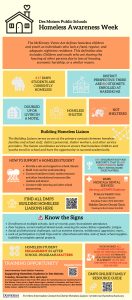Next week, November 15-19, is the first ever Homelessness Awareness Week at Des Moines Public Schools. The week of awareness is about educating educators, staff, and families about the needs in our community.
“Homelessness happens for many reasons, and there is homelessness in your school, even if you can’t see it,” said Lyn Marchant, who leads a team of more than 70 homelessness liaisons stationed in schools throughout the district. “As our awareness increases, we can more rapidly identify a child who may be experiencing homelessness and connect the family to resources and make referrals that to prevent a situation from becoming more serious and unstable.”
The district has identified 817 students experiencing homelessness this year, equivalent to the student population of Harding Middle School. If students experiencing homelessness in Des Moines were their own school district, it would be larger than 200 of Iowa’s 327 districts.
“We have the systems and ability to support our students socially and emotionally during difficult times, but the first step is knowing the signs and knowing there are supports available to support students who are facing these challenges,” Marchant said. “School staff have relationships with parents and caregivers and are the frontline defense to seeing the changes in behavior or hygiene, noticing if a student is unusually tired or hungry. Because of the trusting relationships schools have with families, they are the best support for making sure families are connected to the right services to ensure their safety and success.”
Students experiencing homelessness often lack the stability and support necessary to be academically successful. According to a report by the National School Board Association, students experiencing homelessness are 87% more likely to drop out of school than their stably housed peers.
How is DMPS addressing homelessness?
In addition to the 70+ liaisons working to identify and support families experiencing homelessness, this week, staff will participate in a survey meant to measure their knowledge of homelessness and ability to identify students who are facing the challenge. The district is also making training available to staff including first-person accounts from students experiencing homelessness.
School districts like DMPS that use the Community School Model bring community services into the school, can help students meet the challenges of both poverty and homelessness. Community Schools can offer afterschool programs, tutoring, mentoring, health clinics, and other support services to students and their families. These services help students overcome the obstacles of living in poverty or attending school while homeless, ultimately increasing academic achievement, including increasing attendance and academic success while decreasing disengagement and dropout rates.
What do students want their teachers to know about being homeless? Seven students were willing to share their feelings.
Autumn: It may be hard, but don’t judge them. I want them to be like, “Okay they’re homeless, how can I help them?” Treat them like they’re normal. Other kids might make fun of them because they smell. Help them get a shower and supplies.
Sean: Homeless youth will not always have time to complete homework. A lot of us will need extra time to complete things. We have extra things to worry about like where we are going to sleep at night or where to get food. School goes on the backburner for our needs.
Isaac: It’s horrible. It’s hard. If you aren’t getting sleep every night, you won’t be at school every day. Keep an open mind.
David: Sleeping in a parking garage – – – – – – – sucks. We usually have to scavenge for food. We’re usually depressed as – – – – because we have nowhere to go.
Tony: It sucks, it really sucks being homeless.
Cody: There’s always people out there willing to help you, you just have to find the right person.
Nick: It’s not always their fault.
“Addressing homelessness begins with awareness,” Marchant said. By developing the understanding that homelessness does not define a person, but rather is something that a person has experienced, will help our school community develop systems to support students and families in times of crisis.”
For many students experiencing homelessness, school is often the only place of stability in their lives. Classroom teachers and other school staff play an important role in creating a classroom and school environment that is safe and supportive for all students. This is especially important for students who are highly mobile and have experienced the trauma that often accompanies homelessness. DMPS prioritizes keeping students in their school of origin, because of the relationships and supportiveness of school staff. This consistency is the key to maintaining stability, preventing gaps in education, and providing equitable opportunities to their peers. DMPS schools support access to the basics of food and clothing, to access to healthcare and transportation. It has never been more important for school staff to be aware of supports and resources available to students. Schools are the entry point for services that could be life changing for a student and family.






